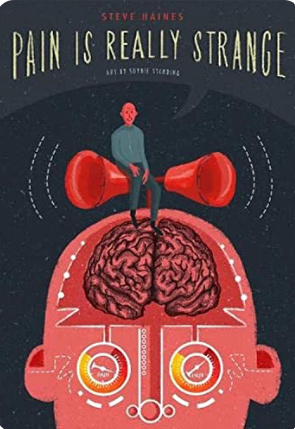Pain is really strange. That’s the title of a helpful graphic novel by Steve Haines that draws upon decades of pain research, including newer models for understanding this complex sensory experience.
After all that research, collating, reading, learning, and understanding, this is the summary statement the authors have come up with.
It’s a different message from what you and I grew up with. As a kid in the playground at my primary school in New Orleans, Louisiana, I had a specific complaint about my school. The different play structures were on cushy black mats, forming islands in a sea of gravel. We often played ‘It’ games, which required the target to run around on the gravel, trying to catch us as we jumped from island mat to island mat without falling into the sea of doom. That’s how I saw it, and, by the way, I wasn’t very good at this game. Day after day, I returned late from break to my classroom, stopping by the nurse’s office to have her pick gravel pieces out of my knees. (WHY, oh WHYYYYY, would they cover a kid’s play area with tiny pieces of sharp rock that could easily get wedged into the skin with any impact!!!) I spent so much time making this detour that I received a certificate at the end of the year for being the ‘Clumsy Caboose.’ Hmph. But I digress.
The truth is that this is the traditional model of pain that we are all accustomed to. You fall over, you break the skin, it hurts, it heals, and it feels better. There is a clear explanation for this acute pain, and with a little medical attention to ensure no more gravel is stuck under the scabs from the last incident, the expectation is that this too will improve quickly. Until tomorrow’s break.
But pain is strange. And though we all appreciate the above model, we all have had experiences with little variables that mean this neat explanation doesn’t always follow quite so literally. Sometimes I’d enter that office in a bloody mess, filled with tears, frustrated with myself that here I am again. Sometimes I would be fine, eager to get back to the classroom where we were going to start playing with Bunsen burners. Sometimes it would help the pain if I put some ice around the wound, whereas other times I couldn’t be bothered with something cold and wet running down my leg. I may try to rub the area, or I may instead feel it would be best not to go anywhere near it. Sometimes I was tired and wanted my mom, and it took longer to collect myself after this incident. Sometimes I wasn’t in the mood for the snickering the ‘Clumsy Caboose’ would invariably receive when returning to the room ten minutes late, again. Sometimes I didn’t want to go outside because that was a stupid game, and I didn’t want to play. But if forced to head outdoors, I would wonder if my old scab was starting to feel a bit uncomfortable. What’s worth noting, though, is that despite a similar injury and the same expectation of recovery, there was a very variable experience of pain.
And emotion. And social inclusion. And avoidance. And maybe even a hint of non-sensory-induced pain signal. Strange.
This is where modern pain understanding picks up. Research is now focusing on rewriting the traditional narrative of pain as a direct signal traveling from the point of injury, tissue damage, or harmful alteration of pressure or temperature stimuli up to the brain. This does happen often. Pain is an alarm system for the brain to let the person know that an injury requires attention to enhance survival. Through a host of complex chemical interactions, nociceptors under the skin are ready and waiting to detect any kind of changes that may signal injury, so they can then sound the alarm. Part of the alarm includes systems for creating inflammation, which only signals to other important cells to get to work on repair.


It may increase swelling, which helps widen the channels of blood vessels, enabling the right repair and infection control teams of the immune system to reach the point of injury. It may also increase heat, which, as it turns out, is important because the entire immune system functions more efficiently at elevated temperatures. Pain is present, traveling through the peripheral nerves to the central nervous system of the spine and then the brain, to alert you to stop playing island hop and go get yourself to your favourite chair in the nurse’s station. This is the standard operating process. (And think for a moment about how many times this will interfere with this process, casually applying ice packs to reduce heat and swelling or consuming anti-inflammatory medication immediately after impact…) In acute pain, this is all a very effective system, which typically results in our survival.
But studies have already shown the variables involved in this process going off-piste. If the role of pain is to alert and protect, then there will naturally be concern about quickly avoiding danger before those pain signals become too debilitating. If there was a rabid dog in my sea of gravel when I took a dive, it would be very possible that I wouldn’t have even noticed a pain signal until my body dialled down the fight-or-flight response as I shot up to the top of a play structure out of the way of a miserable mutt. Countless studies have documented this experience, including cases of significant bodily harm where pain does not register until the body perceives it is in a place of safety to tend to the injury. Other studies have shown the opposite, with a classic story of a construction worker jumping onto a nail that pierced through his boot. He screamed in agony all the way to A&E where careful removal of the boot showed no physical damage to the foot at all (the nail went through his toes!).
There are two different mechanisms at play here: the first involves wider areas of the brain making unconscious (or subcortical) assessments of the situation and moving the body with a delay in the interpretation of sensory signals coming up through the spine. The second mechanism involves the role of the wider cortex in the conscious interpretation of the signals that have made it to the brain, notably signals from visual input and pressure within the boot, rather than damage signals at all.
But the inconsistencies don’t end there. Classic studies of war veterans describe the differences in pain complaints and morphine use when faced with different outcomes of their injuries. Those who knew an injury meant a ticket home experienced less use of pain reliever medication than those who believed they would have to return to the front line, now weakened. Clever studies have recreated scenarios where people feel excluded from social participation and found that acute pain reports after receiving a painful intervention were greater when feeling stressed by being part of the out-group. The conclusions drawn from these pieces of evidence highlight how pain alerts us to something being wrong that may impact our survival, and it may be more than just the actual injury. It could be being kicked out of the village, which would make us highly vulnerable and likely to be killed without the protection of the group, or being taken from the safety of a hospital back to enemy trenches, which, of course, may also have been my embarrassing experience when walking back into my classroom with all eyes on my late arrival.
Other studies have demonstrated that eliciting happy or sad moods has a direct impact on the perceived negativity of a painful stimulus, with corresponding increases in neuronal activity in the areas of the brain that overlap when processing both painful sensory and emotional experiences related to pain—namely, the amygdala, insula, anterior cingulate cortex, and prefrontal cortex. It is concluded that if feelings of upset, anxiety, or fear are present within a certain context, the body will be more sensitive to the alarm systems going off within it as a protective mechanism to keep us safe. When we have learned that a particular situation is dangerous and, therefore, to be feared (WHYYYYY would there be a gravel play area???), the entorhinal cortex becomes activated to engage emotional systems and intensity perception areas in anticipation of forthcoming pain. This emotional learning experience then heightens the pain sensation, resulting in either avoidance behaviours (and increased isolation and low mood) or greater distress if another injury occurs.
In another fMRI study that examined how the brain reacts to various stimuli, the role of distraction was proven. Every parent knows that kids can have their focus redirected from a painful bump or jab when they’re shown a funny video or engaged with random, entertaining questions. In a study involving adults who were given a memory task while undergoing a painful stimulus, they reported experiencing less pain when distracted by the activity. But that’s not all. This study used an opioid blocker to demonstrate that this distraction did NOT reduce pain signals when natural opioids were blocked. This indicates that when distracted, our bodies naturally release opioids to minimize the pain signals entering our central nervous system. This is just one more way in which acute pain and injury are not as straightforward as once believed.
This only scratches the surface of the extensive literature demonstrating that our experience of pain is influenced by factors that go well beyond the specifics of the acute injury itself. The old Cartesian model is incorrect. Unfortunately, this complexity creates challenges. However, by starting to comprehend the intricacies of pain in the context of acute injuries, we can begin to challenge the traditional medical model and gain insight into how chronic pain can develop. It’s not a linear, 1:1 relationship between injury and pain, which can help us make sense of ongoing pain without a current injury, a clear medical cause, or a past injury that should have long since healed.
Because, pain is really strange.
You can find Steve Haines graphic Novel, ‘Pain is really strange’ here.
To learn more about managing pain in a holistic way, explore our pain service here. We offer personalised support and evidence-based treatments to help you understand and overcome both acute and chronic pain.

